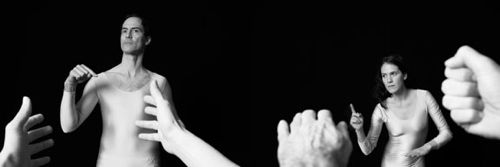If you haven’t checked out New York Close Up lately, you really should.
Two recent films, Liz Magic Laser Talks To The Hand and David Brooks Is In His Element, are just two more examples of how the series can make strong interdisciplinary connections. Both offer viewers the chance to see contemporary artists as researchers, analyzing information learned in order to inform their work. Liz Magic Laser examines hand gestures in contemporary presidential State of the Union addresses as she builds a multi-sensory performance piece. David Brooks, on the other hand, uses his experience as a volunteer with conservation biologists in the Amazon basin region of South America to allow for more opportunities to be “in the field” (literally) and for hands on experience with the wildly diverse ecosystems of the this region—to “witness evolution itself.”
Early in Liz Magic Laser’s piece, just shortly after you find yourself hypnotized by the rhythmic clicking of the camera shutter, the artist describes thinking about “the choreography that is being used to persuade the public.” This intense interest in and examination of gesture, particularly through presidential addresses, becomes a driving force in the collaboration with two Merce Cunningham-trained dancers for her work The Digital Face. Viewers find themselves winding through a systematic and complex investigation into the kinds of things gesture can communicate, which certainly has implications for how students create arguments, art works and even public presentations.
The most recent David Brooks film is likewise a layered glimpse into the “front end” of his art. For Brooks, his work with conservation biologists utilizing a consistent multi-disciplinary approach serves as a model for his own artistic practice. An intriguing part of the film involves the fact that you don’t see one of the sculptures influenced by his volunteer work until the very end, and even then you are left wondering a bit more about what it looks like and what it would be like to walk among the fishes.
Teaching with Liz Magic Laser and David Brooks can include a comparison of how each artist approaches their research differently and how they interact with their collaborators in distinct ways. It can also include a frank discussion about the possibilities when it comes to how contemporary artists approach the creative process.




